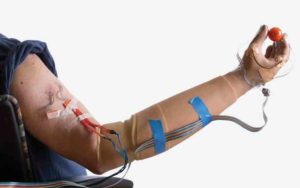Prosthetic Limbs that Can Feel
 Phantom Limb Syndrome is most commonly thought of as a painful and distressing disorder, in which an amputee experiences pain, tingling, or other unpleasant sensations in a lost limb. The phenomenon is thought to originate in the cortical homunculus, the collection of neurons that represent a map of the body in space. Even after a limb is severed, the neurons that represent that limb still exist in the brain.Now scientists are using the phantom limb to develop prosthetics that can not only be moved by an amputee, but that can actually experience sensation in the phantom limb:
Phantom Limb Syndrome is most commonly thought of as a painful and distressing disorder, in which an amputee experiences pain, tingling, or other unpleasant sensations in a lost limb. The phenomenon is thought to originate in the cortical homunculus, the collection of neurons that represent a map of the body in space. Even after a limb is severed, the neurons that represent that limb still exist in the brain.Now scientists are using the phantom limb to develop prosthetics that can not only be moved by an amputee, but that can actually experience sensation in the phantom limb:
We show that implanted peripheral nerve interfaces in two human subjects with upper limb amputation provided stable, natural touch sensation in their hands for more than 1 year. Electrical stimulation using implanted peripheral nerve cuff electrodes that did not penetrate the nerve produced touch perceptions at many locations on the phantom hand with repeatable, stable responses in the two subjects for 16 and 24 months. Patterned stimulation intensity produced a sensation that the subjects described as natural and without “tingling,” or paresthesia.
Hat tip: New York Times. Photo by Russell Lee.
===============
Dent the Future is a conference series that tackles the art and discipline of visionary leadership. The next Dent The Future conference is coming up March 22-25, 2015. Register here.
